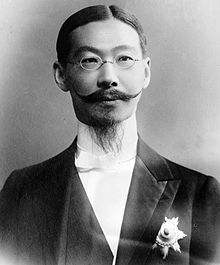Lu Zhengxiang: from Confucius to Christ
Noyelles-sur-Mer is an unremarkable village with a remarkable World War II graveyard. Situated at the mouth of the River Somme, Noyelles was the headquarters of the Chinese Labour Corps during World War I, which explains why its cemetery contains almost as many graves as the village has inhabitants.
It may be a surprise to find the graves of so many non-combatants so far from home, but even more surprising is that over half of the 841 men buried at Noyelles died after Armistice Day. From Sung Hsi P’eng who died on November 11, 1918, to Ch’iu Hsiu Feng, who passed away on March 23,1920, more than 450 labourers died when the fighting was well and truly over. So-called Spanish Flu did for some of them, but at least as deadly was what was euphemistically known as “battlefield clearance”. In accident after accident, Chinese labourers who had survived the war years were blown into an early grave while clearing unexploded ordnance.
The Great War truly was a world war, its global impact reaching as far as East Asia. When war began in 1914, the recently established Chinese Republic opted for neutrality, fearing that it would get dragged into a battle it could not control. However, conflict was not so easily avoided.
In November 1914 the north-eastern port of Qingdao (Tsingtao), which had been governed by Germany since 1898, was occupied by Japanese and British troops. When, shortly afterwards, Japan demanded control of the whole of Shandong province, the Chinese realised their only hope of regaining control was to win a place at the peace negotiations when war eventually ended. To that end, the Chinese president offered Britain 50,000 troops. His offer was rejected.
The following year the Chinese tried again, offering thousands of unarmed labourers in return for a place at the peace conference. After some initial reluctance, and significantly later than the French and Russians, the British eventually accepted the offer, allowing tens of thousands of Chinese labourers to travel to Europe from 1916 onwards to repair tanks, assemble shells and dig trenches.
The contribution of these Chinese labourers to the war effort was immense but, despite working and dying for the British until 1920, the Chinese did not get what they wanted at the Versailles Peace Conference. To their dismay, Shandong was handed over to the Japanese.
The Chinese delegation at Versailles was led by the remarkable minister of foreign affairs, Lu Zhengxiang. Even though he was placed under enormous pressure, he refused to sign the Treaty of Versailles, the only delegate to take such a courageous stand.
In many ways, Lu’s life mirrored that of his nation in the first half of the 20th century. Born into a Protestant family, he developed an early love for the West and served his country as ambassador to the Netherlands and to Russia. He married a Belgian woman and, under her influence, became a Catholic in 1911.
The post-war years were a time of great political disappointment for the Chinese Republic and for Lu, despite Shandong being eventually returned to China in the 1920s. As the republic began to fracture, Lu’s wife became ill, precipitating his retirement from domestic politics. After a short stint as China’s prime minister, Lu moved to Switzerland where he tended to his wife and worked as ambassador to Switzerland and the League of Nations.
As his wife’s health deteriorated, he read the works of Elisabeth Leseur with her and went on a pilgrimage to Rome on her behalf. He was devastated when she died in 1926, and resolved, as an act of loyalty, to become a Benedictine monk in Belgium, entering the Abbey of Saint-André near Bruges in 1927 as a postulant. With China now politically isolated, Lu entered his own period of seclusion. However, this period of isolation eventually came to an end when Japan again took control of part of the Chinese mainland, an event that found its way into a book written by one of Lu’s friends. Hergé’s The Blue Lotus, the fifth volume of The Adventures of Tintin, owes a great deal to the author’s friendship with the Chinese monk.
…..
After the Nazi invasion of Belgium, Lu was caught up in the political maelstrom. When the monks were expelled from their monastery, he began work on a wonderful book, From Confucius to Christ, and took on a public role in Bruges until the Gestapo raided one of his talks and arrested members of the audience. He had little choice but to keep his head down for the rest of the war.
When Lu died in early 1949, the Chinese Labour Corps and his own role at the Versailles Peace Conference were all but forgotten. However, history has a strange way of reviving memories. On this Armistice Day we should recall not only the soldiers who died for their country but the labourers who assisted them and a certain politician turned Benedictine monk who rose above the troubles of his age.
Roy Peachey is the author of Out of the Classroom and Into the World (Angelico Press). His first novel, which focuses on the Chinese Labour Corps, is due to be published next year by Eyrie Press
This article first appeared in the November 9 2018 issue of the Catholic Herald.

No comments:
Post a Comment